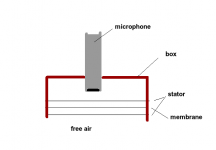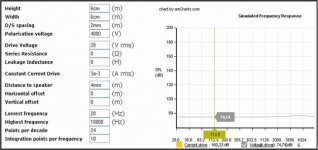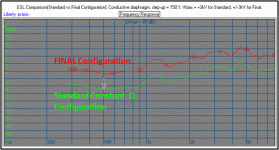I've recently bought a Behringer ECM8000 mic, to measure the sensitivity of some test-panels.
The sensitivity of my test-panels is however always 10-15dB below the calculated sensitivity. By sensitivity I mean the pressure at the edge of the membrane, confined to a small box. (see the attached image)
This way all the force on the membrane should become pressure (as long as the box is much smaller than the wavelength). So I could use the following formula for the pressure:
p = F/A = e0*Upol*Usig / d^2
(from Loudspeaker & Headphone handbook, 3.15)
e0 vacuum permitivity: 8.8e-12
Upol polarizing voltage: 4kV
Usig signal voltage: 28V
d membrane-stator distance: 2mm
(F total force on the membrane)
(A membrane surface, but this cancels, FYI, I used an r=3cm circular unit)
giving: p = 0.25Pa ~ 82dB SPL
But when I measure the sound-pressure with my microphone I measure a pressure of -70+/-2dBSPL, which is 0.06Pa and I very consequently get this value, which is obviously much lower than what I expected.
I'd really appreciate it if people would want to repeat this experiment.
If you measure without the "box" around the microphone, you measure half the pressure, because the other half of the pressure will be radiated on the other side of the membrane. So you can just put your microphone very close to the stator and measure that pressure.
What is going on here? Am I overlooking something?
things I've ruled out:
membrane conductivity is OK
the "box" isn't leaking any pressure
The sensitivity of my test-panels is however always 10-15dB below the calculated sensitivity. By sensitivity I mean the pressure at the edge of the membrane, confined to a small box. (see the attached image)
This way all the force on the membrane should become pressure (as long as the box is much smaller than the wavelength). So I could use the following formula for the pressure:
p = F/A = e0*Upol*Usig / d^2
(from Loudspeaker & Headphone handbook, 3.15)
e0 vacuum permitivity: 8.8e-12
Upol polarizing voltage: 4kV
Usig signal voltage: 28V
d membrane-stator distance: 2mm
(F total force on the membrane)
(A membrane surface, but this cancels, FYI, I used an r=3cm circular unit)
giving: p = 0.25Pa ~ 82dB SPL
But when I measure the sound-pressure with my microphone I measure a pressure of -70+/-2dBSPL, which is 0.06Pa and I very consequently get this value, which is obviously much lower than what I expected.
I'd really appreciate it if people would want to repeat this experiment.
If you measure without the "box" around the microphone, you measure half the pressure, because the other half of the pressure will be radiated on the other side of the membrane. So you can just put your microphone very close to the stator and measure that pressure.
What is going on here? Am I overlooking something?
things I've ruled out:
membrane conductivity is OK
the "box" isn't leaking any pressure
Attachments
But when I measure the sound-pressure with my microphone I measure a pressure of -70+/-2dBSPL, which is 0.06Pa and I very consequently get this value, which is obviously much lower than what I expected.
I'd really appreciate it if people would want to repeat this experiment.
If you measure without the "box" around the microphone, you measure half the pressure, because the other half of the pressure will be radiated on the other side of the membrane. So you can just put your microphone very close to the stator and measure that pressure.
What is going on here? Am I overlooking something?
I haven't used your "box" method to check SPL, but do regularly use the near field measurement technique to make sure my panels are operating as expected. You can use the generalized version of the Walker equation to calculate expected NF SPL for a given D/S, Vpol, and Vsignal.
This website has a handy calculator for the generalized Walker equation: (thank you arend-jan
Electrostatic Loudspeaker (ESL) Simulator
Entering the data for your case shows you should expect to see about 75dB measured NF at the center your ESL panel.
In practice, my panels are generally within 1dB - 2dB of the expected SPL when operating properly.
Uninsulated stators result in near perfect match with theory.
Insulated stators drop from theory by an amount determined by the thickness, bulk resistivity, and dieletric constant.
Suggestion:
To make sure your microphone and measurement technique is working as expected, you might measure a known quantity like a dome tweeter placed on a large board measured with a swept sine wave of 2.83Vrms and measured at 1m. If you get close to the curve and SPL shown on the datasheet, you can feel confident in your measurement equipment and technique.
Attachments
Last edited:
So in the case there is no box around the mic, I should get 75 dB, from which follows that with the box I should get 81dB. (same as I calculated)
If the calculation works well for you. It seems I can't blame the calculation.
I do use an uninsulated stator made out of aluminum mesh, with 1.3mm between the individual aluminium fibers. Which I think shouldn't make any difference for the calculated results.
I've calibrated my microphone from the sensitivity which was in the datasheet. I've measured my mission 760i speakers with it, and the results were consistent with the datasheet.
It is off course also quite easy to hear that the sensitivity is just way lower than could be expected when I compare it to my normal speakers.
If the calculation works well for you. It seems I can't blame the calculation.
I do use an uninsulated stator made out of aluminum mesh, with 1.3mm between the individual aluminium fibers. Which I think shouldn't make any difference for the calculated results.
I've calibrated my microphone from the sensitivity which was in the datasheet. I've measured my mission 760i speakers with it, and the results were consistent with the datasheet.
It is off course also quite easy to hear that the sensitivity is just way lower than could be expected when I compare it to my normal speakers.
I don't see anything wrong with your calcuation of diaphragm Force, but it is not immediately obvious to me that putting a box over a near field microphone will boost measured SPL by 6dB. In general I have found placing physical barriers near ESL diaphragms tends to reduce the output.So in the case there is no box around the mic, I should get 75 dB, from which follows that with the box I should get 81dB. (same as I calculated)
If the calculation works well for you. It seems I can't blame the calculation.
A few questions:
1) From your comments, can I assume that you measured a -6dB drop when you removed the box?
2) How close was the microphone to the diaphragm?
3) What are the dimensions of the box?
4) Does the box cover just the driven area of the diaphragm? or does it contain undriven area like that stator frame edges.
Answers to the questions:
1. yes
2. with the box: It doesn't matter, as long as it's inside; when measuring without the box: 2-5mm, then it's more or less constant
3. about 2cm high and the same diameter as
4. it contains everything. Like in the picture, no air can get in or out of the box (I push the box against the panel and then it's closed.
I use the box because it's a nice way to measure without having to worry about the panel-micropone-distance. (easier to setup and results are better reproducible)
The reason I get double the pressure is that the membrane is almost unable to move (compared to having no box).
Because the membrane doesn't move no pressure is lost by pushing airwaves to the open side. Normally a halve of the force a membrane generates will create a wave forward and half the force pushes a wave backward. But this way all force (pressure) will be used to create pressure in the box.
In practice this seems to work, because the answer to your first question is yes.
1. yes
2. with the box: It doesn't matter, as long as it's inside; when measuring without the box: 2-5mm, then it's more or less constant
3. about 2cm high and the same diameter as
4. it contains everything. Like in the picture, no air can get in or out of the box (I push the box against the panel and then it's closed.
I use the box because it's a nice way to measure without having to worry about the panel-micropone-distance. (easier to setup and results are better reproducible)
The reason I get double the pressure is that the membrane is almost unable to move (compared to having no box).
Because the membrane doesn't move no pressure is lost by pushing airwaves to the open side. Normally a halve of the force a membrane generates will create a wave forward and half the force pushes a wave backward. But this way all force (pressure) will be used to create pressure in the box.
In practice this seems to work, because the answer to your first question is yes.
The reason I get double the pressure is that the membrane is almost unable to move (compared to having no box).
Because the membrane doesn't move no pressure is lost by pushing airwaves to the open side. Normally a halve of the force a membrane generates will create a wave forward and half the force pushes a wave backward. But this way all force (pressure) will be used to create pressure in the box.
In practice this seems to work, because the answer to your first question is yes.
Aaah. Basically the box is small enough that it completely dominates the load the diaphragm has to move. Makes sense.
So, where does this leave you in your disconnect between theory and experiment?
Hmmmm... since you are able to measure NF and get results -6dB below the "boxed" SPL, perhaps you could take some NF measurement of some other ESLs. This would give you an idea if the issue is with your ESL, or the measurement setup.
With your ESL putting at nearly -12dB below what you expect, it seems to me there must be a problem with the bias charge. Is it possible the resistor between bias supply and diaphragm has failed open? This happened to me once. Try jumping it and see if the SPL increases.
Do you have a neon light charge indicator hooked in line between your bias supply and the diaphragm? This would let you know if there is a leakage path somewhere that is lowering the bias charge on the diaphragm. With your small panel, you shouldn't see much flashing activity from the neon bulb at all.
http://www.diyaudio.com/forums/planars-exotics/153773-esl-technical-questions.html#post1958015
The bias should be good. I've measured it (almost) directly by charging a small HV-cap with the bias-supply. I discharge the small cap into a larger cap after which I measure the voltage over the larger cap. This way I can measure the voltage quite precisely.
And it almost can't be the foil, yesterday I've measured the voltage directly from the diafragm and it is the same. I've tried with two different diaphragms, aluminised and clear mylar with kontactchmie 100 antistatic.
I'll try to calibrate the microphone again. Maybe it's just that. (but then I'm a bit disappointed by the sensitivity of my panel)
edit: I don't have other "good" test subjects to compare the ESLs with. Only some old final80i's but the membrane of those isn't that good anymore.
And it almost can't be the foil, yesterday I've measured the voltage directly from the diafragm and it is the same. I've tried with two different diaphragms, aluminised and clear mylar with kontactchmie 100 antistatic.
I'll try to calibrate the microphone again. Maybe it's just that. (but then I'm a bit disappointed by the sensitivity of my panel)
edit: I don't have other "good" test subjects to compare the ESLs with. Only some old final80i's but the membrane of those isn't that good anymore.
I've measured my final 80i units and the pressure peaks at -84dB@0.283V (although not very constant over the diaphragm, but that might be due to the bad membrane)
If I recall correctly the specs of this panel are:
Upol = 3kV
Transf = 1:100 (but effectively 1:400 because it the membrane and stator carry the opposing signal)
Usig = effectively 112V
d = 1.5mm
The pressure should then be 0.65 Pa, or 89dB SPL, that's a bit higher than maesured, but stators perforation isn't very fine and there's a thick layer of coating. So it doesn't seem to be a too bad calculation...
I've also done the calibration again, still with the same results. Next week I'll try calibrating the microphone at the university, then I'm sure that that won't be the problem.
If I recall correctly the specs of this panel are:
Upol = 3kV
Transf = 1:100 (but effectively 1:400 because it the membrane and stator carry the opposing signal)
Usig = effectively 112V
d = 1.5mm
The pressure should then be 0.65 Pa, or 89dB SPL, that's a bit higher than maesured, but stators perforation isn't very fine and there's a thick layer of coating. So it doesn't seem to be a too bad calculation...
I've also done the calibration again, still with the same results. Next week I'll try calibrating the microphone at the university, then I'm sure that that won't be the problem.
I just realized I made some critical mistakes in that last calculation.
The sensitivity measured sensitivity is -74dB@0.283V. And the expected sensitivity is 83dB@0.283V. That's again almost the same error I had before.
Monday I'll try to callibrate the test-microphone with a real dB meter. That might give different results than calibrating from the sensitivity found on the internet.
The sensitivity measured sensitivity is -74dB@0.283V. And the expected sensitivity is 83dB@0.283V. That's again almost the same error I had before.
Monday I'll try to callibrate the test-microphone with a real dB meter. That might give different results than calibrating from the sensitivity found on the internet.
I just realized I made some critical mistakes in that last calculation.
The sensitivity measured sensitivity is -74dB@0.283V. And the expected sensitivity is 83dB@0.283V. That's again almost the same error I had before.
You don’t mention specifically so I will ask…when measuring the Final 80i, are you performing a NF(Near Field) measurement? or a “boxed” measurement?
With the specifications given for your Final 80i:
Vpol = +/-3kV polarization on the stators
Transformer step-up = 1:100
D/S = 1.5mm
I would agree that the NF SPL should be something close to 84dB for 0.283Vrms input.
In post#8 you mention a factor of 4 (ie effect step-up of 1:400) increase in sensitivity for the Final configuration(oppositely charged stators with driven diaphragm) relative to the standard configuration(charged diaphragm and oppositely driven stators). This should be only a factor of 2(ie 6dB). Perhaps this is the calculation mistake you mention?
Attached is a plot from a couple years ago showing my experimental verification of the 6dB increase in sensitivity for the Final Configuration.
Attachments
Yes, that's exactly what I did wrong. (the other thing was just reading 38 instead of 48 from the screen)
My quick (but wrong) thought was that the quadrupling of the capacitance would give a quadruple output, but it just doubles it. (which is good, since the power-output indeed quadruples)
My quick (but wrong) thought was that the quadrupling of the capacitance would give a quadruple output, but it just doubles it. (which is good, since the power-output indeed quadruples)
- Status
- This old topic is closed. If you want to reopen this topic, contact a moderator using the "Report Post" button.
- Home
- Loudspeakers
- Planars & Exotics
- measuring sensitivity of ESLs


